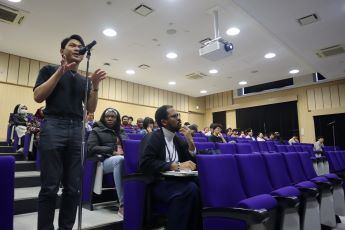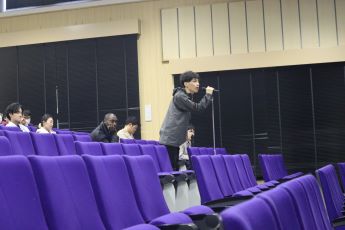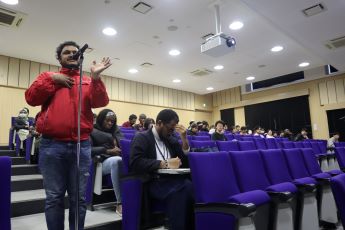- Home
- プログラム生/Ally生の活動報告
- 第12回 Student Monthly Progressを開催しました
第12回 Student Monthly Progressを開催しました
5月24日 (金)、第12回 Student Monthly Progressを開催しました。
4名の大学院生が自身の研究内容について発表を行いました。
【発表者】
1. JANG Eomseob:Division of Bioresources
<Development of serodiagnostic methods for the detection of Mycobacterium bovis infection in cattle using recombinant antigens produced by Mycolicibacterium smegmatis>
2. TIYAMANEE Wisa:Laboratory of Infectious Diseases
<Immunoinhibitory receptor programmed death-ligand 1 expression anddisease progression of chronic infectious diseases by using bovine leukemia virus experimentally infected sheep>
3. BARNES David Atomanyi:Division of Bioresources
<Insight into the genetic diversity of Mycobacterium bovis isolated from cattle in Ghana>
4. MAEZONO Keisuke:Laboratory of Public Health
<Association between nuclear membrane deformation and pathogenesis in West Nile virus infection>
【座長】
KODUA Emmanuel:Laboratory of Genetic Medicine
SEOK Bong Soo: Laboratory of Biochemistry
❖座長レポート❖
Four students introduced their research during the Student Monthly Progress Meeting.
JANG Eomseob’s research topic is on the development of serodiagnostic methods for the detection of Mycobacterium bovis infection in cattle causing Bovine tuberculosis (bTB). Tuberculin Skin Test and Interferon-Gamma Release Assays are the officially approved in vivo diagnostic assays by WOAH; however, due to its complexity and unspecificity, a novel assay needs to be developed. JANG is implementing serodiagnosis by improving its low sensitivity due to the limited capability of Esscherichia coli (E. coli) in producing recombinant antigens for detection of M. Bovis infection. He changed the host cell from E. coli to Mycolicibacterium smegmatis (M. smegmatis) and then recombinant antigens were measured. Based on its outcome, the lateral flow immunoassay for on-site rapid diagnosis will be developed.
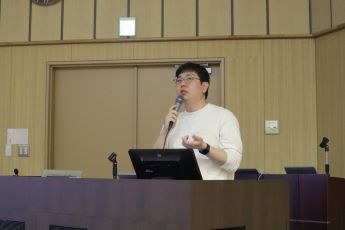
TIYAMANEE Wisa has been utilizing a sheep model to study bovine leukemia virus (BLV) to apply in cattle;however, the lack of available reagents for sheep has limited the immunological studies in sheep. TIYAMANEE infected sheep with BLV and then isolated peripheral blood mononuclear cells (PBMCs) from blood. To examine the effect of BLV in immune exhaustion and disease progression through PD-1 and PD-L1, PBMCs were stained with anti-bovine PD-L1 mAbs and then measured via flow cytometer. Lastly, BLV proviral load were measured by quantitative PCR. PD-L1 expression in peripheral B cells and BLV proviral load in the blood showed the positive correlation which implies possible involvement of PD-L1 molecules in disease progression of BLV infection in sheep.
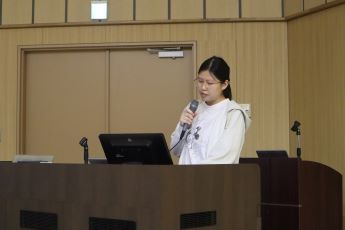
Main Author BARNES David presented on the title: Insight into the genetic diversity of Mycobacterium bovis isolated from cattle in Ghana. Considering the impact of Mycobacterium bovis in his home country, he collected suspected bovine tuberculosis (bTB) samples from cattle in some selected slaughterhouses in Ghana. With his main aim of determining the genetic diversity of mycobacterium species circulating in the cattle population in Ghana, he characterized the cultured isolates by spoligotyping and Mycobacterial Interspersed Repetitive Units- Variable Number of Tandem Repeats (MIRU- VNTR). 6 spoligotypes were differentiated from the 30 M. bovis positive isolates. Among them, the most predominant was SB0944, which is known to be circulating in the West African nations. His research outcome suggested that the SB0944 predominant strain has been circulating in Ghana for a considerably longer time, hence its observation as the most diverse.
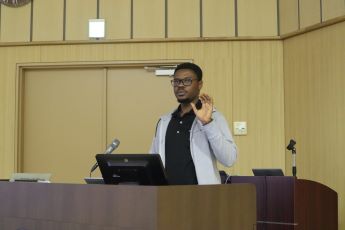
Main Author MAEZONO Keisuke presented on the title: Association between nuclear membrane deformation and pathogenesis in West Nile virus infection. His research investigated the effect of West Nile Virus (WNV) on the nuclear structure and its association with viral pathogenesis. He assessed the nuclear morphology, in cells infected with WNV to express C protein by employing phosphorylation and polymerization of nuclear lamina were analyzed by Phos-tag SDS-PAGE and coimmunoprecipitation of Lamin A/C with Lamin B1. His results showed that WNV infection and C protein expression induce aggregation and discontinuity of nuclear lamina in the nucleus. As well as the induction of phosphorylation of Lamin A/C C in C protein expression inhibited the polymerization of the nuclear lamina.
C protein expression also perturbed the nuclear-cytoplasmic distribution of host proteins, including innate immune response factors and TDP-43. His research suggested that C protein-induced deformation of the nuclear membrane through phosphorylation of lamin proteins resulted in the mislocalization and functional impairment of host proteins.
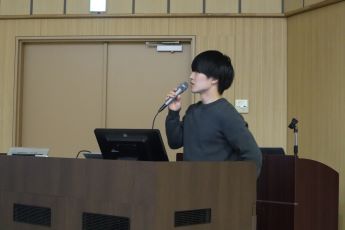
This meeting provides a valuable opportunity to get to know what kinds of research our colleagues do and promotes/encourage possible collaboration; moreover, this event expend our research perspectives and interests.


